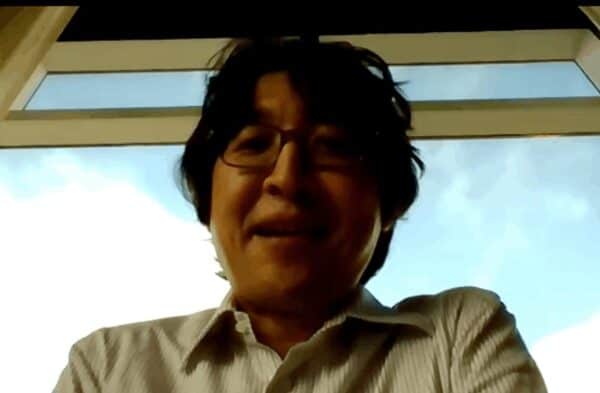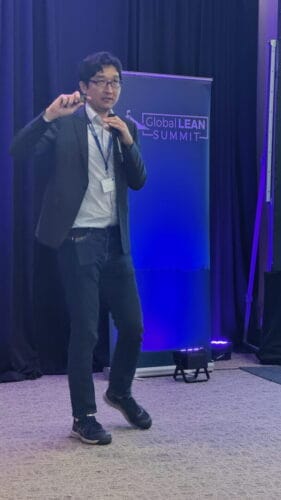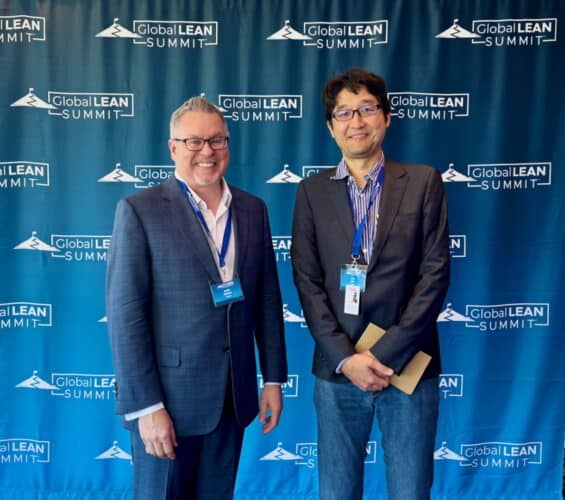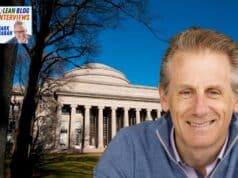Joining me for Episode #397 is Hide Oba. His father was the late Hajime Oba, famous for his work at Toyota and the TSSC, as Steve Spear and I discussed back in Episode #386.
Hide worked with his father at TSSC and also worked with him through the company H&M Operations Management, LLC. He is based in New York City. He says that his mission is to continue spreading his father's wisdom, and I appreciate him doing so here with me on the podcast.

I asked Hide to summarize his father's life and work and he then talks about some of the unique aspects of his approach.
“Going to the shop floor was fun… his hobby.”
Hide tells a story about his father telling Bruce Hamilton, “You should do Kaizen, too,” and you can read Bruce's side of the story here.

In the episode, we discuss the balance between asking questions versus pointing people in a direction. Hide says Hajime “never asked people what they should do,” but he asked questions based on his vision.
Hajime saw TPS as “management engineering” — being very scientific about creating the right structure that allows you to create a kaizen culture. Hajime was also “careful” about the word “scientific” as it is meant to mean “continuous discovery and learning… understanding why.” Hide says his father was “addicted to learning.” Hajime aimed to always learn from the client.
From the new 2nd edition of The Toyota Way (an interview with Jeff Liker about that is coming soon, by the way):
“Oba said “TPS is built on the scientific way of thinking… How do I respond to this problem? Not a toolbox. You have to be willing to start small, learn through trial and error.”
Hide also talks about how his father visited hospitals in Pittsburgh via Kent Bowen and Paul O'Neill.
We also talk about why others have struggled to copy or emulate Toyota. “Stick to Ohno,” says Hide. Solve problems one at at instead of having a big program. He “never asked a company to start by creating a Lean / CI office, sitting and making presentations.” Hajime said the plant manager is the key person, and he would say,
“Come with me and let's go through the process together.”
Why does the idea of “challenge” not mean “asking people to do things that are impossible?” Why did he “hate giving a format for problem solving?”
We discuss all of that and the idea of “respect for people.” Hide says he father taught that we should “respect humanity” — human life is limited and we shouldn't waste it… that's why we do kaizen. He also “saw a lot of waste in his final days” in the hospital.
I'm very thankful that Hide can keep his father's work and legacy alive for all of us.
A full transcript can be found below. Thanks to Lesa Nichols for making the connection between us.
The podcast is sponsored by Stiles Associates, now in their 30th year of business. They are the go-to Lean recruiting firm serving the manufacturing, private equity and healthcare industries. Learn more.


For a link to this episode, refer people to www.leanblog.org/397.
Thanks for listening or watching!
Key Quotes:
“Going to the shop floor was his hobby. He didn't have many hobbies–but going to see the real work, that was fun for him.”
“He never asked people, ‘What should we do?' He always had a vision in mind, and his questions were to make sure we were thinking in the right direction.”
“Dirty is beautiful. A pencil-written board that gets updated every day shows real problem solving, not a fancy PowerPoint slide.”
“Respect humanity means human life is limited–we shouldn't waste it. That's why we do Kaizen.”
“Toyota's strength isn't just TPS–it's the capability to keep giving birth to TPS, again and again.”
Questions and Topics:
- How did you start working with your father?
- How do you help people get past the temptation to think they understand TPS or Lean after learning just a little bit about it?
- What made going to the shop floor fun for your father, and what unique aspects did he notice during these visits?
- What did your father pass along from Taiichi Ohno about the importance of going to the shop floor?
- Can you elaborate on your father's approach to no excuses being acceptable on the shop floor?
- What are the risks of giving advance notice before visiting the Gemba?
- Why did your father prefer dirty boards and handwritten standardized work over fancy presentations?
- Can you talk about your father's perspective on why everyone in leadership should participate in Kaizen?
- How did your father ensure that managers were creating the right environment for problem-solving and Kaizen?
- How did your father view the balance between asking questions and steering someone towards a solution?
- Can you elaborate on your father's concept of TPS as management engineering?
- How does the idea of “challenge” fit into the concept of “respect for people” in TPS?
- What were your father's thoughts on creating a safe environment for making mistakes?
- Can you share your thoughts on the quote from Jeff Liker's “The Toyota Way” about TPS being built on the scientific way of thinking?
- What did your father learn from his interactions with Kent Bowen, Steve Spear, and Paul O'Neill?
- Did your father have the opportunity to work with hospitals through TSSC?
- What was your father's opinion on the term “Lean” versus “TPS”?
- What are some of the challenges organizations face when trying to emulate Toyota?
- How did your father feel about companies creating separate Lean or CI offices?
- What are your plans for continuing your father's work and legacy?
Transcript:
Mark Graban: Hi, welcome to the podcast. It's Mark Graban. This is Episode 397. My guest today is Hide Oba, the son of the late Hajime Oba, who passed away last year. You may recall in Episode 386, I talked to Professor Steve Spear about his recollections of learning from Mr. Oba, who's famous for his work at Toyota and the TSSC organization.
His son, Hide, worked at TSSC and with his father through the company H&M Operations Management. In today's episode, Hide shares his insights and personal reflections on working with his father, what he learned, and what others learned about the Toyota Production System, what a lot of us would call Lean.
Thank you so much for being a guest today.
Hide Oba: Thank you, Mark. Thank you for this opportunity.
Mark Graban: It's a real pleasure and an honor. I thought we could start with your story. How did you start working with your father?
The Journey to Lean
Hide Oba: It was 2001. I was working at a different company as an accountant. I told my company that we needed to reduce inventories, and I was an arrogant accountant telling them, “Hey, you reduce inventory.”
I told my dad, “Hey, I'm doing the same thing as you do.” I told these guys to reduce the inventory. He didn't get angry. He asked me, “What's the Lead Time?” I didn't know what the Lead Time was. I started investigating, and I found out the company's Lead Time was two weeks. I told my father, “Our inventory targets should be two weeks.” He started laughing. “Lead Time is less than one day,” he said.
“How can a product that's less complicated than an automobile take two weeks of Lead Time?” That's when I started to feel like, “My God, my father knows something different than my company knows, or some of these other people that I talk to know.” I begged him to give me the opportunity to work with him. He gave me a project in the U.S., and from there, I started working with him.
Mark Graban: That's such an interesting introduction to his approach. That story makes me reflect that this happens a lot in companies. It's easy for people to think they understand TPS or Lean after only learning one part of it. What are your thoughts on helping people get past that temptation?
Hide Oba: Every time he came to the shop floor, there was always a new point of view. I learned from him, and the companies welcomed him. It's like this never-ending journey; there's always a lot more to do. There are people who get confused, like, “Why did we hit the target, and he doesn't look happy?” On the other hand, it's almost like getting addicted to this journey. You always explore and find something new. I turned out to be one of those people, getting addicted to my father, and I followed him.
Mark Graban: Becoming addicted to learning and improvement–that's a good thing to see in an organization, right?
Hide Oba: Yes, I think so. A lot of people enjoyed it, too.
The Gemba and No Excuses
Mark Graban: I never had the opportunity to work with your father, but I've talked to many people who have. There are always so many great stories about him coming out to the shop floor. I was wondering if you could talk about the importance of going to the shop floor and the unique aspects of his approach.
Hide Oba: Going to the shop floor for him was almost like fun or entertainment. He didn't have much of a hobby, but going to the shop floor was his hobby. First, the detail he captured was completely different.
Once, we went to a factory without talking about training for the people, and we made a program. My father said, “Something is wrong with that program.” We found that on the shop floor, the people were working in a different direction. He was asking us why we were teaching them a different direction because it would confuse them in the real world. None of us had noticed that. Once we changed it, it made the process so much easier for everybody to understand. How carefully he watched these details that were crucial for people was unbelievable.
Mark Graban: Your father had the good fortune to learn from Taiichi Ohno. What did your father pass along about the importance of going to the shop floor?
Hide Oba: I think he said he didn't directly learn from him. He was a second-generation student, learning from people like Mr. Cho. My father did meet with Mr. Ohno once in a while. Going to the shop floor was just so normal for him. I still remember getting a phone call from him and he'd say, “I'm outside the factory. Let me in.” He'd go into the factory and start pointing things out.
That was a way a lot of Toyota managers behaved. They didn't give advance notice so that we could prepare. They would come suddenly, and whatever was happening on the shop floor was the result. Any excuses were not accepted. That was their style.
Mark Graban: Tell me more about that. You said no excuses were acceptable?
Hide Oba: Right. For example, a machine was not running for maintenance reasons. I started making excuses, saying, “Today is a bad day. Today, we happen to have blah-blah-blah.” He always looked at me and I would stop making excuses. He only came once a year, and this was happening on that particular day. It was either a miracle or it was happening every day. “Tell me the truth.” I had to say, “Yes, dad, you're right. It's happening all the time. We haven't solved this issue yet. We need to work on it.” No matter how fancy the other results looked, he'd ask, “What's the real problem? If that's the real problem, let's fix it.” I learned that multiple times.
Mark Graban: What's the risk of giving two weeks' notice before visiting the Gemba?
Hide Oba: Then they would do this painting and they'd clean up the whole floor and make nice presentations. It looks nice, but you cannot fool them. Once they start the presentation, they would walk around the planned route, but they would go off the route for sure. They would go to any process and he would start asking, “If that's happening there right now, could that happen to the line that you were working on?” I would have to say, “Yes, sir, you're right. There's no excuse about it.”
Mark Graban: I guess the smell of fresh paint is a dead giveaway.
Hide Oba: Yeah, fresh paint, fresh board. He loved those dirty boards with pencils and even handwritten standardized work. He didn't like the fancy PowerPoint standardized work. It's just a piece of paper with a pencil; just keep updating. That's perfectly fine with him or any other Toyota people. That's how I got framed.
Mark Graban: Bruce Hamilton, who I'm hoping to interview, wrote a blog post about your father's work with his company. Bruce was the VP of manufacturing, and your father wanted him to go to the shop floor. The other executives were skeptical. Your father told Bruce, “You should do Kaizen, too.” What's your perspective on the idea that everybody in leadership should be doing Kaizen themselves?
Hide Oba: I think they should have some idea of how they want the process to be improved. My father would watch how a manager was handling a team's dynamics, what guidance he was giving, and what problems he was facing. As a manager, you have to make sure the organization is working on problem-solving. That's something he always wanted management to think about–how to create the right environment for people to do Kaizens and whether those Kaizens are leading to the expected level.
I did a workshop once, and before we started, he gave me a hint and said, “Focus on the positioning of the tools.” I got results in other ways, but we didn't work on that tool positioning. The management was happy because we doubled productivity. But at the end of the day, he came to me and said, “I asked you to work on this tool hanging. What happened?”
I said, “We got the results with different things.” He said, “I know you can do those other Kaizens, but I know you haven't seriously completed this tool hanging. This was a great location. That's why I'm challenging you to work on this Kaizen.” He always wanted us to work on something new so that when the next challenge came, we could add it to our list of things we can do. I think that's why they come to the Gemba–to understand what you can do and where you need to go. He was always looking for that gap, not just the opportunities.
Mark Graban: I'm curious about the balance between asking questions versus steering someone.
Hide Oba: I definitely think he had an image of how it should be. He never asked, “What should we do?” He always had some answer. It was okay if my answer wasn't perfectly right, but he wanted to make sure people were going in the right direction. He wasn't asking for the answer. His questions were always based on his true north, his vision. He had something he wanted us to work on, and his question was, “Am I thinking the right way or not?”
Lean as Management Engineering
Mark Graban: You mentioned “management engineering.” Can you elaborate on how your father viewed TPS as management engineering?
Hide Oba: Oftentimes, I hear, “What are the incentives to pay to the people so that they will work on Kaizens?” My father would say, “Toyota is not going to pay a dollar for every Kaizen idea.” The whole process is designed so that if a problem happens, the process will stop. The manager's responsibility is to solve the issue. Therefore, they have to work on the problems.
If you cannot meet the target, somebody will come and help to accomplish it. This dynamic is carefully designed. If you design a process with a lot of inventory, a lot of people, and a lot of extra space, you don't really have to work on Kaizen.
I think that's where my father was really careful. “Are we sure that the management structure is a design that forces us to do Kaizen?” It's not Kaizen by fear, but Kaizen by necessity or ownership. People feel comfortable pulling the cord and saying, “Sir, I cannot accomplish this. Can you help me?” That's when they know they are learning something new. Then they can say, “Next time, let me do it by myself.” That's how you get a Kaizen culture.
Mark Graban: The word “challenge” comes up a lot. How do you see the idea of challenge being respectful in a TPS environment?
Hide Oba: I don't think they ever give an impossible challenge. My father had a road map of how he would improve a process, and he would challenge us according to that road map. He's not asking us to do something impossible. He told people never to give a challenge that is illogical. It's mentally challenging, but it's not impossible to accomplish.
If I look back at the results, it might seem crazy if someone had told me to do it from day one. But the leaders always have that vision, and they challenge us step by step. That's the beauty of this Toyota Way.
Mark Graban: Toyota talks about developing people through problem-solving. How do you strike the balance between a specific question that tells someone the answer and a question that's so open-ended that it's not helpful?
Hide Oba: My father never gave answers, but in many cases, he gave us an opportunity to play around and explore and learn. When I talked about my son's education, my father started reading about those systems. He said, “Wow, there's some similarity there.” In many of the corporate worlds, they don't think about how to create a safe environment to make mistakes, like preschools. That's why a lot of people are afraid to challenge themselves–because if there is a mistake, they might lose their job. That's why he said, “You have to accept that we might fail, but it's important. Keep it safe.”
Mark Graban: I have a coffee mug that says, “My Favorite Mistake.” I have a separate podcast series about mistakes we've learned from. We often talk about creating a safe environment to make mistakes.
Hide Oba: I think they always challenge something where it's okay to make a mistake and you learn a lot from it. They don't give you a huge challenge at the beginning. I didn't start designing the layout of a factory until very late in my career. Even a year later, I would look at a layout and think, “I made some mistakes.” Fortunately, it was a fixable mistake. He never gave us a challenge that could not be fixed.
Mark Graban: It also sounds like an argument for having equipment on wheels, so that when you inevitably make a mistake with a layout, it's fixable instead of being in the concrete.
Hide Oba: That's why they design racks and machinery with wheels and make them easy to move. A lot of places already have equipment with deep roots in the concrete, so moving them is a huge deal. Before we learned to design the monuments, he always challenged us to think about a good layout.
The Scientific Way of Thinking
Mark Graban: In the second edition of his book, The Toyota Way, Jeff Liker quotes your father as saying, “TPS is built on the scientific way of thinking. How do I respond to this problem? It's not a toolbox. You have to be willing to start small and learn through trial and error.” What are your thoughts on that quote?
Hide Oba: I'm not surprised. I think he was cautious about the meaning of “science.” I think a lot of people see science as an authority. It's like, “There's a guru in the factory who knows everything about so-called science. They are the authority, so you ask them, they define the process, and we follow.”
I think Taylor's science is a bit different because science is continuous discovery and learning. Every time we test something, we might find something new. It's a continuous journey. I think Dr. Bowen wrote that every employee at Toyota is like a real scientist. At the beginning, you start with what you know, but you might find a new science and have to continuously update yourself.
One view of science says, “Somebody is going to give you the answer. You follow them.” The other view says, “No, it's a continuous improvement.” You never reach the complete answer, but there is always something better. What is it? Let's look for it. If you have only a few experts, you'll only find a few new sciences. But if every employee is looking for a new science, you will find millions.
Mark Graban: That makes a lot of sense. I haven't heard anyone say it exactly that way before, of science as authority.
Hide Oba: There's a joke on a t-shirt that says, “I'm an engineer, consider myself right.” I know it's a joke, but I don't know what percentage of them think, “I'm an engineer, I'm right, just follow me.” I think my father challenged so many engineers: “Come to the shop floor. I don't care what you say; what's happening on the shop floor is not necessarily what you are saying. We need to understand the logic behind this science.”
Working with American Leaders
Mark Graban: I was curious about your recollections of your father working with Kent Bowen, Steve Spear, and Paul O'Neill. What did he learn from those interactions?
Hide Oba: That's something he always appreciated. He thought Dr. Bowen was his good friend. They came from completely different backgrounds but seemed to understand each other about TPS very fluently, even though my father's English wasn't that good.
What my father learned from them is that in the United States, there's a lot more study done on coaching and double-loop learning–theories about how people learn. My father saw that and attended some Harvard case study classes. He felt it was an unbelievable environment. He wanted to practice that on the shop floor. He tried to shift toward more questioning and away from a strict, traditional Japanese teaching style. He wanted a method that didn't drive people by fear but by respect for humanity.
I would like to say that all those people my father met, like Paul O'Neill, were people he learned from. He learned about their styles. He also learned words that were not popular in Japan, like “challenge.” He tried to understand that concept and thought, “Wow, there are so many things to learn from the United States.” It was a game of catch: he was learning, and on the return, he would share TPS.
Mark Graban: Do you know if he ever had the opportunity to work with a hospital?
Hide Oba: While doing the TSSC work in Pittsburgh, that was the hospital. After that, I don't think he had a project in a hospital. He did in healthcare equipment, but not a hospital itself.
Mark Graban: A famous Wall Street Journal article about your father asked, “How does Toyota maintain quality? Mr. Oba's hair dryer offers a clue.” It talks about him going to a supplier that had a robotic oven costing $300,000, and he used a $12 hair dryer to do the work just as well. What are the lessons there–that simplicity can sometimes be more effective?
Hide Oba: Yeah, I've been to the factory where they put the hair dryer. He trusted engineers to give a good answer, but he never believed the story until he saw it. The first thing he would say is, “Let's try. What could go wrong if I buy a $12 hair dryer and it doesn't work?” Most cases, the things he tried were very cheap but worked effectively. So why do we need to think about millions of dollars?
TPS vs. “Lean”
Mark Graban: The article used the word “Lean.” Do you know what he thought about that word, as opposed to talking about TPS, the Toyota Production System?
Hide Oba: I don't know if you want to compare Lean and TPS, that's a tough question. He never considered himself a Lean expert. He would always say TPS. One thing he was concerned about is that Lean is becoming so big that sometimes the original philosophy might disappear. That's why he wanted to stick to Taiichi Ohno's teachings.
The other thing is that Lean is also the opposite. He wanted to say, “You want to be Lean, but thinking is also important.” You need a healthy body and a good mindset. We shouldn't forget that part of TPS. It's not just less inventory, less people, or less lead time. A professor in Japan, Dr. Fujimoto, once said in his book that “Toyota's strength is not TPS, it's the capability to give birth to TPS.” They designed it, implemented it, and tested it. That capability is what makes Toyota unique.
He would say, “Your body needs to be Lean, but your mindset also has to be very sharp, continuously thinking and challenging.” He didn't want people to forget about that part.
Mark Graban: When you say Lean was getting too big, you mean too popular? And there was a risk that it would get misunderstood?
Hide Oba: For example, in Taiichi Ohno's book, “Workplace Management,” there's a chapter that says, “Standard time should be the lowest time.” If you can't accomplish it, the team leader will come and help you solve the issue. A lot of versions now say, “It's okay to have an 80 percent growth. Let's use the average.” Once you allow that kind of calculation to creep inside, you design a process that doesn't need Kaizen or problem-solving. That was his concern. Are we really understanding what Taiichi Ohno tried to do, or are we changing it into a completely different monster?
Mark Graban: The Wall Street Journal article quoted your father as saying, “What the Big Three are doing is creating a Buddha image and forgetting to inject a soul in it.” What do you think about that provocative statement?
Hide Oba: It's a very similar point. What they are saying is simple: “Problem-solve one by one.” But in practice, every day, it's going to look dirty. If you design the process like that, you really have to do problem-solving. If managers just want quick results, that might not be the right version.
For example, Andon lights. My father would go to a factory and see so many lights flashing, but nobody was reacting. At Toyota, if the Andon light goes on, you see immediate action. Some manager will come and jump on the problem. That's what I always see when I visit their factories–really fast reactions.
Mark Graban: Why do you think other organizations struggle when they're emulating Toyota?
Hide Oba: That's a tough question to answer. The whole TPS toolbox is not the TPS group's tool; it's the management's tool. Andon, Kanban, or any of these tools are used by the team leader, the group leader, the normal people on the shop floor. To make that happen, the management takes time to understand. The system evolves. It's still an ongoing question, and I don't have an answer to it.
Mark Graban: So there's a difference between a small group running improvement projects and a whole management team that has those skills. What are your thoughts?
Hide Oba: And that's a major difference in my father's approach. He never asked a company to create a new office. I've been to factories where they have a Continuous Improvement Office, a Lean Office, and a separate office, and they're all making presentations.
My father thought you don't have to start there. He thought the plant manager was the key person. He would say, “You come with me and let's go through this whole process together, understand the problems, and start working on problem-solving together.” He was never asking them to make an office first. He didn't like that. He wanted to work with the plant managers or COO first.
Legacy and Future
Mark Graban: Maybe a final question for you, Hide. Can you talk a little more about the work you're doing and your plans for continuing your father's legacy?
Hide Oba: My brother and I talked about this after my father's passing. One of his favorite phrases was “respect humanity.” He would say that human life is limited, therefore we shouldn't waste their time. That's why we need to do Kaizen–because we want people to add more value to society. The creativity, curiosity, and passion are something we can continue.
We saw a lot of waste during my father's final days in the hospital. I know that if my father could have gotten out of the hospital, he would have gone back and said, “We need to do Kaizen.” My brother and I are now thinking about that. We want to continue his teaching and pass that passion to the next generation.
Mark Graban: Thank you for sharing that. It makes you think about the waste in patient care and the impact it has. That's why we have to do Kaizen. I hope that inspires listeners.
Hide Oba: The doctors and nurses are very professional and talented people. I want to say thank you to all the doctors and nurses who tried to help my father. I know that he would say such talented people are not necessarily focused on the right thing. If we provide a better environment for them to do their work, more people will be saved and have more quality time with their families.
My father's desire was that these professional people should be released from waste to do what they are capable of doing. He would want to say thank you to the doctors and nurses, and he hopes these people can spend more time on adding value, not just wasting time. That's some of the passion for humanity that we would like to continue.
Mark Graban: Thank you. That's beautifully said. I want to express my condolences to you and your family. I appreciate that you could take some time to share these reflections and stories that we could document here.
Hide Oba: Mark, thank you very much for this opportunity. It was a great opportunity. It gave me an opportunity to rethink what my father had done and gave me more positive memories, helping us get through this hard time. Thank you very much.
Please scroll down (or click) to post a comment. Connect with me on LinkedIn.
Let’s build a culture of continuous improvement and psychological safety—together. If you're a leader aiming for lasting change (not just more projects), I help organizations:
- Engage people at all levels in sustainable improvement
- Shift from fear of mistakes to learning from them
- Apply Lean thinking in practical, people-centered ways
Interested in coaching or a keynote talk? Let’s talk.









Here is a great story shared by another son, Yasu Oba, on LinkedIn:
We were very fortunate to have over a ten year relationship with Mr Oba. we learned so much through his questions and humility is seeking understanding of our company’s opportunities. TPS (Thinking People System) inspired us to develop our EDGE (Employees Dedicated to Growth and Excellence). Our learning allowed us to reduce waste and keep 90% of our Furniture production in Hickory NC while so many left and became importers. The lessons allowed us to provide industry leading Lead times for Upholstery and wood, as well as customization options to improve our value to our customers resulting in steady growth in sales and profits. We shared bonuses with our employees until our parent company prohibited it because other divisions could not. Personally I am honored and inspired by witnessing such a wonderful person so intent on helping people achieve their potential.
Thanks for sharing your story and reflections, Jay.